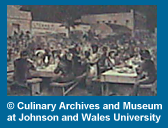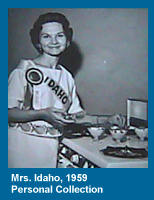Chicken in every pot; chicken strips, even Chicken Little. During the 1930s most chickens were raised in America for egg production. Fried chicken served at Grandmother's Sunday mid-day dinner was a rare, special treat. Then customs changed. After World War II, an elderly man named Sanders -- dressed in a white suit -- changed American food patterns forever. By 1998, Americans were eating nearly 50 pounds of chicken annually. Who says one person can't make a difference?
DOOMSDAY DIET:
DINING IN THE DARKNESS
How to plan for the unthinkable? The Cold War placed a heavy burden on Americans: should shelters be constructed in the family backyard? What should one do IF the bomb came . . .? Survival manuals provided advice . . .
FOOD SUPPLY REQUIREMENTS
As an absolute minimum, a 90 day supply of food is recommended; 6 months is more realistic; 24 months would not be beyond the realm of common sense
UNAVAILABLE FOOD
The following conditions will probably prevail in the event of a nuclear attack. Fresh milk will be impossible to obtain and canned evaporated or dry powdered milk must be substituted. Fresh eggs will be scarce. Since chickens have great tolerance for radiation, fresh eggs will probably be one of the first staples available after a nuclear attack
SELECTING FOOD
Buy only foods that will be enjoyed because shelter occupants will be under emotional stress. When buying shelter food select proper size containers to eliminate left-overs that might be difficult to preserve
SHELTER FOODS
Store, prepare, and serve the following inside shelter facilities: bacon; corned beef hash; sausage; meat balls; chili con carne; tamales; chipped beef; salmon steak; crab meat; shrimp; clams; oysters; smoked bologna; country cured ham; au gratin potatoes; spaghetti; macaroni; buckwheat mix; canned cheese; tomatoes; brown bread; flour; relish; maple syrup; oatmeal; hot cereals; baby foods as needed
It might be sensible to keep a few packages of vegetable seeds in the shelter for a do-it-yourself post-war project. [9: 1]
Did You Know?
 |
|
SOUTHERN-STYLE FRIED CHICKEN
According to many food historians southern fried chicken may be the ideal all-purpose, all-occasion American food. Served hot or cold, it is enjoyed by young and old and appreciated at both formal and casual meals. Southern-fried chicken frequently is complemented by biscuits, corn-on-the-cob, beans, or Cole slaw. [9: 5] |
|

FOOD AT THE INN
In the west, when you stop at an inn, they say . . . What will you have? Brown meal and common doings, or white wheat and chicken fixings?' - that is, 'Will you have pork and brown bread, or white bread and fried chicken?
Frederick Marryat
A Diary in America, 1839 [9: 2]

WHITE DINNERS: CHICKEN, CLAMS, AND CAULIFLOWER
During the late 19th century, wealthy Americans in Newport hosted theme parties. This one was "white."
The table was decorated with clusters of white carnations, poppies, and roses; the meal was served on pure white porcelain; the meal itself was white: Clams and cream of celery soup; fish dressed with white sauce; fair breasts of young chickens; cauliflowers smothered in creams, and salads in beds of crisp celery. Over this repast presided the hostess -- dressed in white from top to toe.
Illustrated American
July, 1890 [9: 3]

TIN CAN AND PANTRY STAPLES
John T. Dorrance first prepared canned soup concentrate in 1897. At that time the tin can was a synonym for progress and women's liberation from cooking. During the 1950s, canned soups became the basis for numerous casseroles placed on the family dinner table. Remember tuna casserole prepared with cream of mushroom soup -- with potato chips sprinkled on top? [9: 4]

THE NEW RAGE: STEAK ROAST DANCES
Steak Roast Dances were popular during the post-war era especially at Florida resorts. Fifty-gallon oil drums were prepared as charcoal grills, and fires maintained at hot, medium, and slow cooking temperatures. Fourteen-ounce steaks were grilled upon request. Once the order was received, the steak was seared over the hot fire, then transferred to the medium grill, or the slow grill if the diners wished to dance. [9: 6]
|





